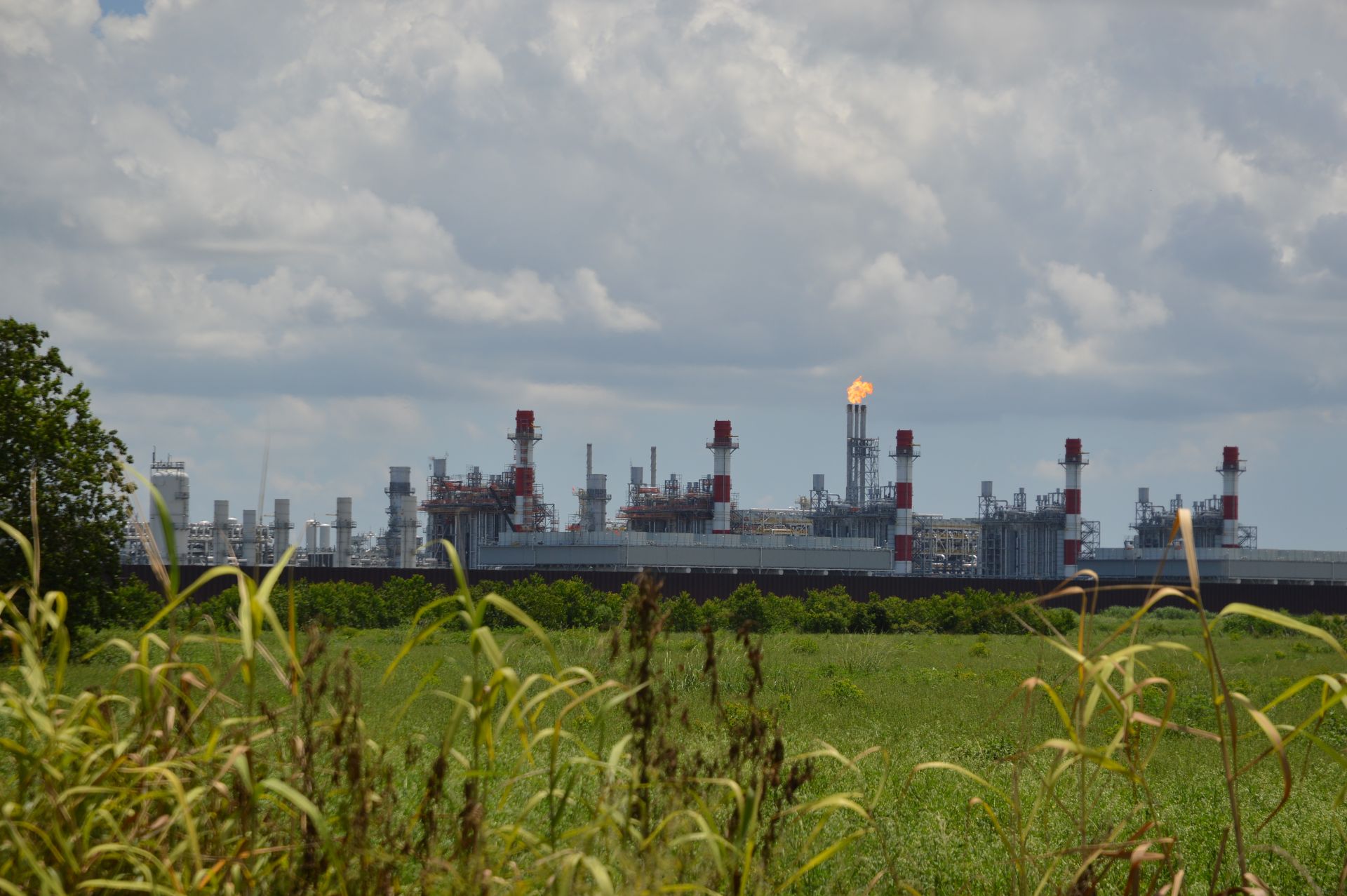Louisiana LNG terminal plans massive expansion – and neighbors are fearful

Ironton, Louisiana – A new liquefied natural gas export terminal south of New Orleans, already among the world’s largest, is proposing an expansion that would double its size – and neighbors and environmental groups are worried about the project’s safety risks and pollution.
“It’s a lot of risk. What if this thing explodes?” asked Wilkie DeClouet, a 60-year-old former chemical plant worker who lives in Plaquemines Parish, down the road from the Venture Global Plaquemines LNG terminal on the Mississippi River. “If it explodes, it’s going to be catastrophic.”
He explained that his community is protected from the Mississippi River by dirt barriers called levees, which are crossed by gas pipelines supplying the LNG terminal. If one of the pipelines exploded, DeClouet worried, “it’ll blow the levee and flood this whole part of Louisiana.”
The Federal Energy Regulatory Commission (FERC) is holding community meetings on the proposed expansion of the Plaquemines LNG terminal at 5 p.m. on Aug. 12 at the Belle Chasse Auditorium, at 8398 LA-23, in Belle Chasse, LA; and at 5 p.m. the next day at the Port Sulfur YMCA at 278 Civic Dr., in Port Sulphur, according to a FERC public notice.
When the Plaquemines LNG terminal started operating in December, the 630-acre export facility beside the Mississippi River was already among the world’s largest, with 36 liquefaction units that cool natural gas for shipping overseas, four 200,000-cubic-meter LNG storage tanks, two gas-fired power plants, and the capacity to export up to 24 million metric tons of LNG per year.
The terminal already has a substantial environmental footprint, releasing about 3,630 tons per year of health damaging air pollutants, including nitrogen oxides, which contribute to smog, according to data on the Oil & Gas Watch database. The plant is also permitted to emit more than 8 million tons of greenhouse gases annually – as much as 1.6 million cars and trucks driven for a year.
Since the rise of the hydraulic fracturing boom in the U.S. reduced the price of natural gas, exporting liquefied natural gas has become a booming business – with eight LNG export terminals built since 2016, four under construction, and 28 more projects to build or expand export facilities proposed, according to public records compiled on the Oil & Gas Watch database.
If all these projects are built, they could emit over 78 million tons of greenhouse per year, as much as 16 million cars and trucks driving for a year, according to data from EPA and other sources on Oil & Gas Watch. All of this greenhouse gas pollution could create $13.5 billion in climate-related costs, such as damage from flooding and drought, and more than 16,000 climate-related deaths, including from heatwaves.

On July 15, the Arlington, Virginia-based Venture Global Capital announced plans to roughly double the size of Plaquemines LNG, asking FERC to approve an expansion to as much as 52 million metric tons per year. The more than doubling of the plant’s capacity could more than double its pollution impact, although the exact numbers are not yet available.
“This project worsens the climate crisis and puts Plaquemines residents at even greater risk from toxic emissions, traffic, and environmental destruction,” said Gregory N. Swafford, Southeast Louisiana organizer for Healthy Gulf.
The additional pollution is proposed in a community that is 64 percent people of color and 47 percent low income, with a cancer rate already higher than the national average, according to EPA data compiled by Oil & Gas Watch.
On its website, Venture Global argues the project will create jobs and energy that is needed, in part, for the artificial intelligence boom. “Affordable, reliable energy is critical to supporting the growing global middle class,” the company said. “The current wave of development in AI and the resulting, significant additional increase in demand for base load electricity,” will be supplied by the project.
In June, the company cancelled the planned construction of a new LNG terminal nearby that would have been called Delta LNG, instead saying it would focus its growth on the expansion of the existing Plaquemines LNG terminal. Venture Global is also planning two LNG terminal projects further west in Louisiana on the Calcasieu River.
Residents in Ironton, a predominantly African-American community down the road from the Plaquemines LNG terminal, said they are skeptical that any economic benefits or jobs from the expanded plant will trickle down to them.
Haywood St. Cyr, Jr., 71, a retired pipefitter, said he’s lived in Ironton his whole life and does not believe the company will protect or even think about the health and welfare of residents like him and his neighbors.
“Always, all my life in my parish, the industry always did what they wanted to do, and they never tried to help this community,” St. Cyr said. “If the plant was right there, they never helped us. They think there ain’t nobody back here. To me, it’s a racist thing, but we don’t complain about it. We just pray to God and wish for the best.”
Another neighbor in Ironton expressed concern about the massive expansion project, but asked to remain anonymous because he’s worried about losing his job for speaking out against the industry, which wields political power in Louisiana.
“I’m against the expansion because there will be more risk of explosion to the community, and more risk of pollution,” the man said. “And there are a lot of elderly people here who would be vulnerable to all that additional pollution.”
Elizabeth Calderon, a senior attorney for Earthjustice, said that the area around the Venture Global Plaquemines LNG terminal is already failing federal air pollution standards for microscopic particulate matter, which can trigger heart and asthma attacks; sulfur dioxide, which can cause lung damage and other health impacts; and nitrogen oxides.
“I don’t see how they will be able to double their size without violating national ambient air quality standards – and those are public health-based standards, which is really important,” said Calderon. “This facility is surrounded by environmental justice communities – majority minority and lower income – and these communities are disproportionately impacted by these industrial buildouts.”
She also noted that the terminal is on a narrow peninsula reaching out into the Gulf of Mexico with only one road in and out, which could pose problems for evacuation if there were a fire or explosion at the terminal.
“If there is an accident, there is only one road out,” Calderon said. “If there is an explosion, the threatened area could be quite large, and local residents don't have information on what the impacts could be, how they can protect themselves, or even if they can protect themselves.

Accidents at LNG terminals have happened in the past. For example, an explosion and fire at the Freeport LNG terminal in Texas on June 8, 2022, forced a temporary shutdown of the terminal and evacuation of local residents. Among other incidents, a 2004 explosion at an LNG terminal in Algeria killed 30 people and injured 70.
Beyond FERC approval for the proposed expansion project, the Louisiana Department of Environmental Quality must also still evaluate and approve water and air pollution control permits for the expansion, and the U.S. Army Corps of Engineers must approve permits for destroying wetlands for the construction.
A 13-mile pipeline being built to supply the expanded Plaquemines LNG terminal, called the Evangeline Pass Expansion project, would impact 195 acres of wetlands in a state already being hurt by rapidly disappearing wetlands, which are important for Louisiana’s seafood industry as a a breeding ground for crabs, oysters and fish. Wetlands also help protect the coastal homes and businesses from foods during storms.
Another 27-mile pipeline being built to supply gas to the expanded Plaquemines LNG terminal, called the Gator Express, is expected to impact 70 acres of wetlands.















